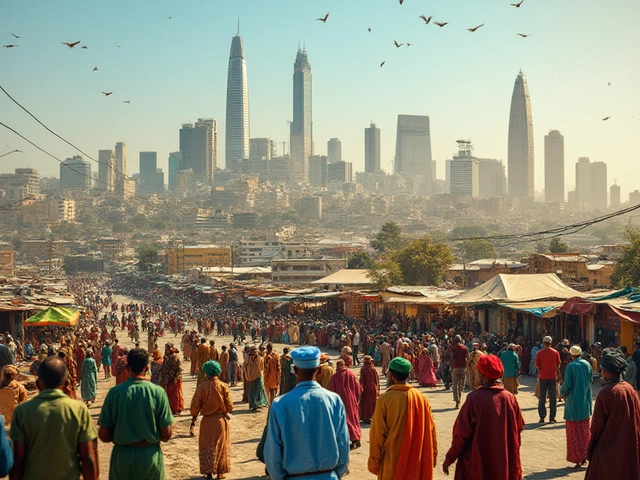Ethiopia is a land where ancient traditions meet a rapidly evolving modern economy. It's a place where history and progress mingle in the bustling markets and rural plains. Despite its rich cultural heritage, Ethiopia often appears in global discussions concerning economic challenges and opportunities for growth.
The topic of wealth in Ethiopia is complex and layered. On one hand, there's the image of a spirited nation making strides in infrastructure and agriculture. On the other, challenges such as unemployment and income disparity persist. This article investigates these themes by examining the economic atmosphere of Ethiopia, the average salaries, and the factors that influence the distribution of wealth.
Incredible transformations have begun to unfold, fueled by both internal milestones and international collaborations. Through understanding these elements, one can glean insights into the country's current economic health and the everyday lives of its people.
- Economic Overview of Ethiopia
- Salaries and Income Distribution
- Agriculture: Ethiopia's Economic Backbone
- Urban vs Rural Wealth Disparity
- Foreign Investments and Their Impact
- Challenges and Opportunities for Economic Growth
Economic Overview of Ethiopia
Ethiopia stands as one of Africa's most intriguing nations, offering a vibrant tapestry of cultural richness and economic evolution. Its economy, one of the fastest-growing in Africa over the past decade, reflects a country on the move. Despite challenges commonly associated with the developing world, Ethiopia is on a path of transformative growth driven largely by agriculture, infrastructure expansion, and a dynamic service sector. The country, formerly dependent on subsistence farming, has made significant strides due to strategic efforts to diversify its economic base and enhance productivity in various sectors. While the GDP figures have been promising, showing an average growth rate exceeding 7% for several years, the reality on the ground reveals a nation grappling with inequities that underscore the complexity of sustainable development.
The International Monetary Fund has recognized Ethiopia's substantial progress, attributing it to targeted government policies and substantial investments in infrastructure, such as the ambitious road and rail networks that connect remote areas to markets. These developments have not only accelerated economic activities but also improved access to essential services for many Ethiopians. A noticeable shift is evident in urban centers where construction activities proliferate, signaling the creation of job opportunities, albeit accompanied by rapid urbanization challenges including housing and basic service provision. Ethiopian salaries, however, vary significantly with many still employed in low-wage sectors, highlighting the need for comprehensive labor reforms to match economic growth with equitable wealth distribution.
"Ethiopia has demonstrated remarkable resilience, leveraging its natural resources and strategic policies to foster growth," notes a recent World Bank report, which also warned of the imperative to address the stark rural-urban divide.
Amid these advances, agriculture remains the backbone of the economy in Ethiopia, employing approximately 70% of the workforce. The country’s coffee, renowned globally, is a testament to the agricultural sector’s pivotal role not just in economic terms but also in cultural heritage. As Ethiopia strives to progress, the challenge remains to transition from rain-fed agriculture to more resilient methods that mitigate the impacts of climate change. Foreign investments have played a significant role in this transition, with initiatives aimed at improving agricultural yields through technology and innovation. With increasing focus on sectors like renewable energy and manufacturing, Ethiopia aims to further broaden its economic landscape.
The wealth disparity between urban and rural areas is marked, with cities like Addis Ababa experiencing more prosperity compared to rural regions where basic infrastructure remains inadequate. This imbalance necessitates policies that bridge the gap, ensuring that prosperity reaches all corners of the nation. Effective reform measures are crucial in altering the landscape of Ethiopian salaries, enhancing productivity, and providing fair wages across all sectors. As international partnerships grow, there's optimism that Ethiopia can convert its economic potential into tangible benefits for its citizens, creating a robust system that upholds human capital as its most valuable asset.
Salaries and Income Distribution
The topic of salaries in Ethiopia opens the door to a broader discussion about economic realities in the nation. Ethiopia, with its compelling mix of traditional economy and nascent modernity, presents a unique picture of salary distributions shaped by geographical, educational, and sector-specific factors. The national average income level is not the highest on the African continent, which often colors perceptions about the country's wealth status. Nevertheless, understanding the dynamics of salaries in Ethiopia requires recognizing the roles played by agriculture, education access, and urbanization, each significantly influencing earning potential.
In big cities like Addis Ababa, salaries can vary markedly from rural areas. Urban settings tend to offer more job opportunities in service sectors, technology, and government roles, which contributes to higher average salaries. Opportunities in agriculture dominate the countryside, a sector traditionally associated with lower incomes. The labor market in Ethiopia is quite diverse, but disparities in wage distribution remain a problem faced by many. In context of Ethiopia, wage differences often reflect educational attainment, occupational choices, and the presence of multinational enterprises investing in specific sectors. For example, the entry of foreign companies in manufacturing has created lucrative pockets of employment yet hasn't fully addressed the larger income disparity.
Interestingly, Ethiopia’s economic strategy has emphasized education as a key driver for labor market upgrades. The government has invested significantly in educational reforms, which are slowly yielding results seen in more skilled labor available in the workforce. Skilled professionals, particularly those in the banking and telecommunications sectors, often command salaries that are higher than industry averages globally. However, a substantial portion of the Ethiopian population remains tied to subsistence farming, thereby preventing them from capitalizing on such investments. The socioeconomic divide is typified by the reality that a significant part of the labor force remains informal, with incomes often not reflecting the nation's economic potential. Ethiopia's economic status remains tightly linked to these diversifying factors.
The World Bank notes that Ethiopia has made significant progress in expanding access to education and addressing poverty, yet challenges in job creation remain crucial considerations for sustainable development.
The Ethiopian government's ongoing efforts to bridge the wage gap are bolstered by policy adjustments and developmental plans aimed at fostering an equitable increase in people's incomes. Programs designed to promote entrepreneurship and SME support play a crucial role in enhancing economic participation, particularly among women and youth. Still, tackling unemployment levels and nurturing a conducive business environment are pivotal to ensuring equitable wealth distribution. Looking forward, as Ethiopia continues its stride towards modernization, ensuring fair salary distributions will play an integral role in shaping both national prosperity and perceptions of wealth in Ethiopia.

Agriculture: Ethiopia's Economic Backbone
Agriculture sits at the heart of the Ethiopian economy, shaping the landscape, livelihoods, and legacies of millions. In a country steeped in history, it's the fertile highlands and sprawling farms that define its contemporary economic narrative. This sector employs a whopping 70% of the population, illustrating not just its importance but its vast reach across Ethiopia. Farming practices, both traditional and modern, contribute significantly to the country's GDP, driving not only national growth but aiding local development. It's in the fields where corn rustles and coffee beans ripen that the true story of Ethiopian wealth begins and is nurtured. These activities account for about 34% of the GDP, as the land yields crops like teff, the tiny staple upon which much of Ethiopia's diet relies.
As the primary source of employment, agriculture supports families, sending children to school and providing the means to access healthcare. Yet, the sector faces numerous challenges, including dependence on unpredictable weather patterns and limited use of advanced farming technology. Economic status Ethiopia is intricately linked with these factors. As the decades progress, the government attempts to modernize and revitalize the industry, bringing in irrigation and improved seed endeavours. These efforts aim to change the face of agriculture from mere subsistence to a sustainable and potentially lucrative field. An official from the Ministry of Agriculture once stated,
"Our pursuit is to infuse modern techniques that will no longer let us be held hostage by droughts."Such ambitions showcase the determination to enhance food security and economic resilience.
Important exports like coffee play a crucial role, as Ethiopia is famously recognized as the birthplace of this beloved beverage. Coffee alone supports a major part of the economy, maintaining Ethiopia's position as Africa's largest coffee producer. This global demand for Ethiopian coffee fuels foreign revenue and culturally roots the country in international markets. The government actively works on improving trade relations to open new markets and expand opportunities. With projects like the Ethiopian Agricultural Transformation Agenda, emphasis is placed on sustainability and market efficiency, tapping into the unique strengths of Ethiopia’s agrarian society. This initiative shows data-supported strategies for improving productivity and value chains, ensuring that agriculture not only survives but thrives amid changing global dynamics.
Urban vs Rural Wealth Disparity
The wealth landscape in Ethiopia showcases a significant divide between urban and rural areas, a gap that has been the focus of policymakers for years. Urban centers like Addis Ababa are bustling with a blend of economic activities, from thriving marketplaces to burgeoning industries, which often promise higher salaries and better living standards. Conversely, rural regions, where the majority of Ethiopians reside, are usually anchored in traditional agriculture and face numerous economic challenges due to limited access to resources and infrastructure.
In urban areas, the presence of better education facilities and job opportunities contributes to relatively higher incomes. There's a visible concentration of wealth, where modern apartments and flourishing businesses suggest an optimistic economic narrative. However, rural communities heavily rely on agriculture, with their economic fate often tied to seasonal conditions and crop yields. Despite agriculture being labeled as Ethiopia's economic backbone, these areas still experience lower income levels due to outdated farming techniques and inadequate market access.
The government has acknowledged these disparities and embarked on several initiatives to bridge the gap. Programs aimed at improving rural infrastructure, such as roads and communication networks, aim to connect these communities to larger economic hubs. Educational campaigns are also underway to equip rural residents with skills that can enhance productivity and income. Additionally, there's a push for developing small and medium enterprises that can thrive in rural settings, offering locals alternative revenue streams.
Strong urban growth has led to increased migration from rural to urban areas, in search of better employment opportunities and living conditions. This migration contributes to rapid urbanization, which brings its own set of challenges, including increased demand for housing and public services. As this trend continues, it underscores the need for comprehensive strategies that address both urban expansion and rural development effectively.
The disparity between urban and rural wealth is not merely a matter of economic statistics but also affects the social fabric of the nation. The rural population often has limited access to healthcare and social services, which can further entrench poverty. This systemic issue requires multifaceted solutions involving government policies, private sector innovation, and international aid. By addressing these areas holistically, Ethiopia hopes to not only reduce the wealth gap but also foster nationwide economic growth.
In his analysis of global economic systems, renowned economist Joseph Stiglitz noted, "Bridging urban and rural disparities is critical for equitable development."
His insights shed light on the importance of inclusive growth strategies. This call to action resonates strongly in the context of Ethiopia, where balancing urban advancement with rural upliftment remains a key challenge.

Foreign Investments and Their Impact
Foreign investments in Ethiopia have played a significant role in shaping its economic landscape, influencing everything from infrastructure to employment rates. For decades, the country has attracted the attention of international investors, eager to tap into its potential. As Ethiopia strives to transition from a largely agrarian economy to one that embraces industrialization and modernization, foreign investments have been pivotal. These investments are mostly directed toward sectors such as agriculture, textiles, and construction, contributing significantly to economic growth and development. The government's strategic efforts to create a conducive environment for investors through policy reforms and tax incentives have also been instrumental.
A notable example of such investments is in the Hawassa Industrial Park, which has attracted global brands eager to participate in Ethiopia's burgeoning textiles and apparel industry. The park exemplifies how these investments are providing employment opportunities for thousands, particularly benefitting the local youth and women. Additionally, the involvement of foreign companies often comes with the transfer of technology and skills, which is crucial for fostering local expertise and capacity building.
Challenges and Opportunities
However, there are challenges. Critics argue that while foreign investments bring in the much-needed capital and innovation, they sometimes do so at a cost. There are concerns over the labor conditions in some foreign-owned facilities, which have sparked debates about the balance between economic benefits and ethical practices. The wealth that foreign investors help create does not always trickle down effectively, which can exacerbate existing inequalities. To address this, policies that ensure fair labor practices and reinvestment in local communities are necessary.
Despite these challenges, it's evident that foreign investments present opportunities. These capital inflows help the country address its infrastructural deficits, creating avenues for better roads, energy supplies, and telecommunications. These developments, in turn, can reduce production costs for businesses in Ethiopia, giving local companies a better chance at competing on a global scale. Also, with the global economy interconnected, Ethiopia's role as a destination for investment increases its visibility and influence on the world stage.
According to the Ethiopian Ministry of Finance, "The emphasis on foreign direct investments is not merely about attracting capital; it's about building a future where the sectors of the economy are diversified and robust enough to sustain growth and provide equitable opportunities."
The balancing act now lies in ensuring that while foreign investments continue to flourish, they do so in a manner that aligns with the country's long-term developmental goals. By nurturing sectors with high growth potential and ensuring equitable growth that benefits all citizens, Ethiopia maintains the potential to transform these investments into lasting economic stability and prosperity.
Challenges and Opportunities for Economic Growth
When you think about economic status in countries like Ethiopia, it's essential to appreciate the dynamic landscape of both obstacles and potential breakthroughs. Ethiopia's development story is a fascinating blend of encouraging economic reforms and persistent issues. One primary challenge is the high rate of unemployment, especially among the youth. Reports suggest that many young Ethiopians struggle to find employment opportunities that match their education and skills. This mismatch between job availability and the workforce can stymie potential economic progress and exacerbate societal issues.
Infrastructure development presents both a challenge and an opportunity. Ethiopia has made significant strides in building roads, railways, and energy provision. These developments typically drive economic growth by enhancing connectivity and access to resources. However, the country's vast rural areas still lack sufficient infrastructure. Bridging this gap is crucial because improved infrastructure can open up rural markets and fuel growth in the agriculture sector, which is Ethiopia's economic backbone. Enhanced rural connectivity can also facilitate the flow of goods and services, dispersing wealth more evenly across the nation.
Another pressing concern is the wealth gap between urban and rural areas, a disparity that persists despite economic reforms. Urban centers like Addis Ababa attract foreign investments and house a burgeoning middle class enjoying modern amenities and higher incomes. In contrast, rural areas, where the majority of the Ethiopian population resides, often suffer from limited economic opportunities. Addressing this divide could involve policies that promote rural development, such as investing in agriculture and small-scale industries, which could be game-changers for regional economies.
On the flip side, Ethiopia's economic growth potential is immense, bolstered by its strategic position and demographic profile. With a population of over 120 million, it is the second-most populous country in Africa, offering a vast market and labor force. This demographic advantage, coupled with political willingness for reform, creates an ecosystem ripe for attracting foreign direct investment. In recent years, the Ethiopian government has responded by easing regulations and undertaking privatization initiatives to entice investors.
"Ethiopia is on the cusp of an economic transformation driven by both its youthful population and ambitious infrastructural projects," notes a World Bank economist. This reflects a global sentiment that sees Ethiopia as both a challenge and an opportunity worth the investment.
Lastly, climate change presents an important yet often overlooked medium to long-term challenge. For an agriculturally dependent economy like Ethiopia, unpredictable weather patterns threaten food security and economic stability. Tapping into sustainable agricultural practices and diversifying the economy can mitigate these risks and provide new avenues for economic growth. By investing in technology and education, Ethiopia can empower its workforce to adapt and thrive in changing economic conditions, setting a precedent for other nations in similar predicaments.

 Investing In Ethiopia: How Much Do You Really Need?
Investing In Ethiopia: How Much Do You Really Need?
 Understanding Ethiopia's Employment Structure: Key Aspects and Insights
Understanding Ethiopia's Employment Structure: Key Aspects and Insights
 Exploring Common Occupations in Ethiopia for 2024
Exploring Common Occupations in Ethiopia for 2024
 Coca-Cola Prices in Ethiopia: What You Need to Know
Coca-Cola Prices in Ethiopia: What You Need to Know
 Navigating Employment Opportunities for Foreigners in Ethiopia
Navigating Employment Opportunities for Foreigners in Ethiopia
Douglas Gnesda
November 16, 2024 AT 16:33When discussing Ethiopia's wealth landscape, it's essential to acknowledge the dual realities of rapid GDP growth and entrenched income inequality. The nation's average annual growth rate has hovered around 7% for the past decade, propelled largely by expansive infrastructure projects such as the Addis Ababa–Djibouti railway and a network of regional highways. These investments have facilitated market access for farmers, allowing coffee and teff producers to reach export markets more efficiently. However, the benefits are unevenly distributed, with urban centers like Addis Ababa absorbing a disproportionate share of high‑skill jobs in telecom, finance, and construction. Rural households remain heavily dependent on subsistence agriculture, where yields are vulnerable to erratic rainfall and limited access to modern inputs. The World Bank highlights that despite macro‑economic gains, the Gini coefficient remains above 0.40, signalling persistent wealth gaps. Education reforms have boosted secondary school enrollment, yet the transition from schooling to formal employment is hampered by a mismatch in skill sets, especially in technology‑driven sectors. Moreover, foreign direct investment, while significant in textiles and manufacturing, often concentrates in industrial parks that employ a relatively small segment of the labor force. Labor standards in some of these enterprises have attracted criticism, underscoring the need for stronger regulatory oversight. Agricultural productivity can be enhanced through irrigation schemes and improved seed varieties, but financing these technologies remains a challenge for smallholder farmers. Climate change adds another layer of complexity, as shifting weather patterns threaten staple crop yields and, consequently, household incomes. The government's Agricultural Transformation Agenda aims to address these issues by promoting mechanization and value‑addition, yet implementation gaps persist. Gender disparities also influence earnings, with women in rural areas typically earning less due to limited land ownership and access to credit. Urban migration trends have accelerated, creating pressure on housing markets and public services in cities, which in turn can exacerbate urban poverty pockets. Social safety nets, such as cash transfer programs, have been expanded but their coverage is still insufficient to offset broader economic shocks. In sum, Ethiopia's journey toward equitable wealth distribution hinges on synchronized advancements in education, infrastructure, agrarian reform, and inclusive policy frameworks that bridge the urban‑rural divide.
Abhijit Pimpale
November 22, 2024 AT 00:00The GDP figures often mask the fact that per‑capita income remains among the lowest in the region, especially when you factor in inflation and purchasing power parity.
Eric DE FONDAUMIERE
November 27, 2024 AT 07:26Yo, those coffee exports are dope but most farmers barely see the profit after middlemen take their cut.
Pauline Herrin
December 2, 2024 AT 14:53While the statistical growth is commendable, the underlying socioeconomic stratification warrants a more rigorous analytical framework.
pradeep kumar
December 7, 2024 AT 22:20Urban wage differentials are stark; a civil servant in Addis can earn three times what a rural agrarian household makes annually.
love monster
December 13, 2024 AT 05:46Honestly, the push for industrial parks is a double‑edged sword-creates jobs but can also sideline local entrepreneurs if not managed right.
Christian Barthelt
December 18, 2024 AT 13:13Sure, infrastructure looks impressive on paper, but without effective maintenance plans, those roads become costly pothole museums.
Ify Okocha
December 23, 2024 AT 20:40Foreign capital influx often bypasses the grassroots, reinforcing elite capture of economic gains.
William Anderson
December 29, 2024 AT 04:06Meanwhile, the narrative glorifying investment ignores the labor rights violations that are quietly proliferating.
Sherri Gassaway
January 3, 2025 AT 11:33One might contemplate whether the current development model merely reshapes existing hierarchies rather than dismantling them.
Milo Cado
January 8, 2025 AT 19:00Indeed, fostering inclusive growth requires transparent dialogue between policymakers, civil society, and the private sector.
MONA RAMIDI
January 14, 2025 AT 02:26This whole situation is a tragic comedy.
grace riehman
January 19, 2025 AT 09:53From a cultural standpoint, preserving traditional farming practices while integrating sustainable tech could empower local communities.
Vinay Upadhyay
January 24, 2025 AT 17:20Let’s be real: the government’s hype about “inclusive growth” is often just a buzzword to attract donors, not a concrete strategy. The reality on the ground shows that many of the promised benefits never materialize for the average citizen. In sectors like textiles, wages remain below living standards despite foreign investor claims of job creation. Moreover, the enforcement of labor regulations is weak, leading to exploitative overtime and unsafe working conditions. The agricultural sector, while touted as the backbone, still suffers from limited irrigation and outdated farming tools, keeping yields low. Climate variability adds another layer of uncertainty, with droughts wiping out harvests and pushing families deeper into poverty. Urban migration continues unabated, stretching city services thin and inflating housing costs. Although the government touts infrastructure projects, maintenance budgets are often insufficient, resulting in rapid degradation of new roads. Financial inclusion is improving, yet most rural dwellers lack access to credit, stifling entrepreneurial ventures. Gender gaps persist; women’s participation in the formal economy remains low due to cultural constraints. While education enrollment has risen, the quality of schooling is inconsistent, leaving many graduates ill‑prepared for modern job markets. Lastly, transparency in public procurement is lacking, fostering corruption and misallocation of funds.
Eve Alice Malik
January 30, 2025 AT 00:46Could we see more data on how micro‑finance initiatives have actually impacted household incomes in rural Ethiopia?
Debbie Billingsley
February 4, 2025 AT 08:13The nation’s potential is undeniable, yet the path forward must prioritize sovereignty over external pressures.
Patrick Van den Berghe
February 9, 2025 AT 15:40Infrastructure = progress
Josephine Gardiner
February 14, 2025 AT 23:06In terms of fiscal policy, the recent reforms aim to diversify revenue sources beyond traditional customs duties.
Jordan Fields
February 15, 2025 AT 16:33Interesting.